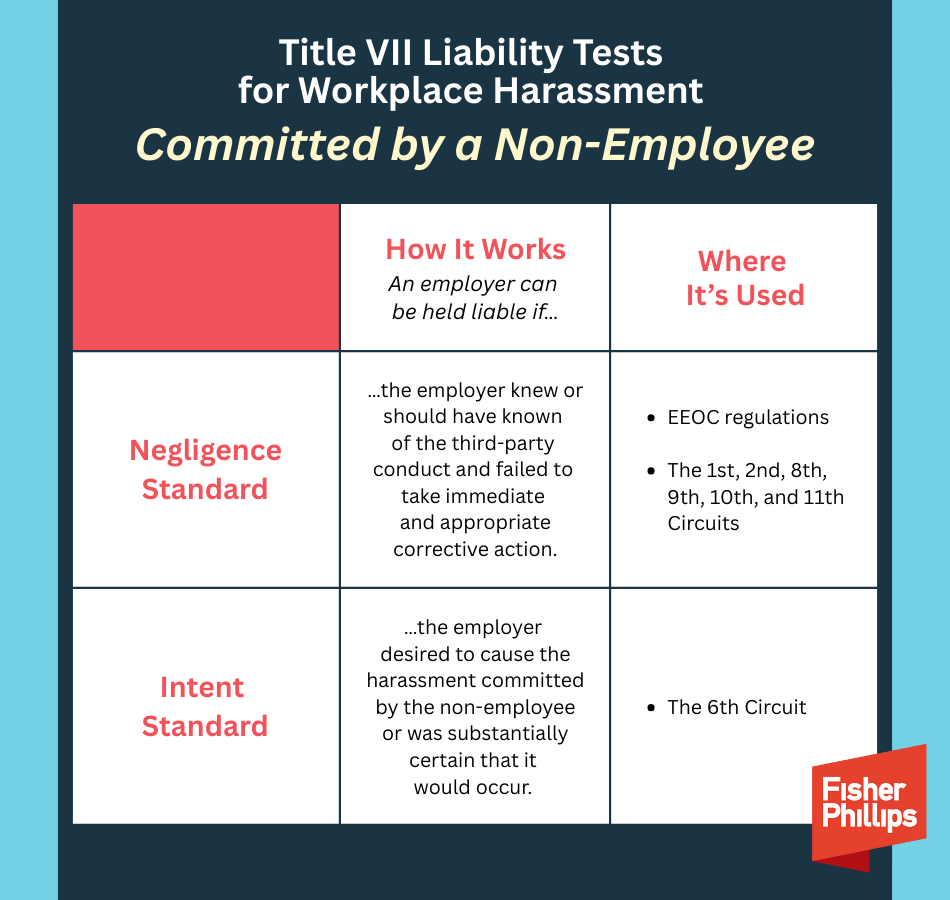FP Snapshot for Construction Employers: Courts Split on Liability Standard for Harassment Claims Based on Non-Employee Conduct
Insights
11.12.25
In this edition of FP Snapshot for Construction Employers, we’ll cover the industry’s heightened risk of harassment claims based on the conduct of a non-employee (such as a subcontractor, inspector, vendor, or any other third party likely to be at a job site), and how a federal court decision in August impacts the risk calculus for employers.
Quick Background
A common misconception is that workplace harassment is unlawful only if the harasser is the victim’s supervisor, but employers can potentially be held liable when the harasser is another coworker or even an individual who is not employed by the company at all. (This is true even if the harasser is not an agent acting on behalf of the company or under its control – and the joint employer theory of liability is beyond the scope of this Insight.)
However, not all courts agree on what standard to apply when determining whether an employer is responsible when an employee is harassed at work by a third-party individual.
|
Terms to Know
|
The Negligence Standard vs. the 6th Circuit’s New Intent-Based Standard
- Negligence Standard. According to EEOC regulations, employers can be held liable under Title VII for a non-employee’s sexual harassment in the workplace so long as the employer knows or should have known of the conduct and failed to take immediate and appropriate corrective action. Most federal appeals courts apply this negligence standard of liability in these types of cases.
- Intent-Based Standard. The 6th US Circuit Court of Appeals expressly rejected that negligence standard in an August 8 decision and held that an employer is liable in such cases only if it intended for the harassment to occur – meaning that the employer desired to cause the harassment or was substantially certain it would occur. (You can read more about Bivens v. Zep, Inc. in our FP deep dive on the case.) The decision, which is binding only on courts within the 6th Circuit, is good news for employers in Kentucky, Michigan, Ohio, and Tennessee, because it makes it harder for plaintiffs to succeed on Title VII claims based on non-employee conduct.
Why This Matters for Construction Employers
Construction employers have increased exposure to third-party harassment claims since job sites routinely involve multiple external parties, such as subcontractors, suppliers, inspectors, and other non-employees.
Further, the EEOC reported last year that harassment in general is prevalent on many construction jobsites, citing industry-specific risk factors, such as decentralized workplaces and workforces that are primarily male. The Biden-era guidance (archived here) said that these factors are “exacerbated by the presence of multiple employers on a worksite, and the cyclical, project-based nature of construction.”
The Bottom Line
Construction employers across the country should continue to take third-party harassment seriously. The 6th Circuit’s intent-based standard of Title VII liability is not the norm nationwide and is at odds with EEOC rules, so even employers in Kentucky, Michigan, Ohio, and Tennessee should remain cautious – especially if operations cross state lines. Employers must also be aware of any additional employee protections that may apply at the state or local level.
|
Will Other Circuits Adopt the Intent Standard? Stay tuned to see how other circuit courts address this issue going forward. Federal judges now have much more power to toss out agencies’ positions on the law due to the Supreme Court’s landmark decision last year in Loper Bright – which is what the Bivens court relied on in setting aside the EEOC’s negligence standard and creating a new one based on its own interpretation of Title VII. |
3 Practical Steps for Construction Employers
Consider taking these three steps to manage your risk of Title VII liability for a non-employee’s conduct:
- Make sure your policies address third-party harassment. Consider updating your workplace policies to clearly outline the types of conduct that will not be tolerated from clients, vendors, and other non-employees, and what steps your company will take if such conduct occurs.
- Train your employees. Managers and supervisors should understand how to recognize third-party harassment and how to promptly address it. Employees should know how to report incidents of harassing conduct from non-employees.
- Take complaints seriously and document everything. Consider designating an experienced person or team to conduct investigations. Make sure to document each step of the process, including any corrective action taken by the company.
Conclusion
If you have any questions about your liability exposure related to third-party conduct, contact your Fisher Phillips attorney, the authors of this Insight, or any attorney on our Construction Industry Team. Make sure to sign up for Fisher Phillips Insights to stay up to speed on the latest developments.
Related People
-
- Collin D. Cook
- Partner
-
- Tami Essis Culkar
- Partner
-
- Emily N. Litzinger
- Partner



